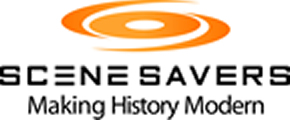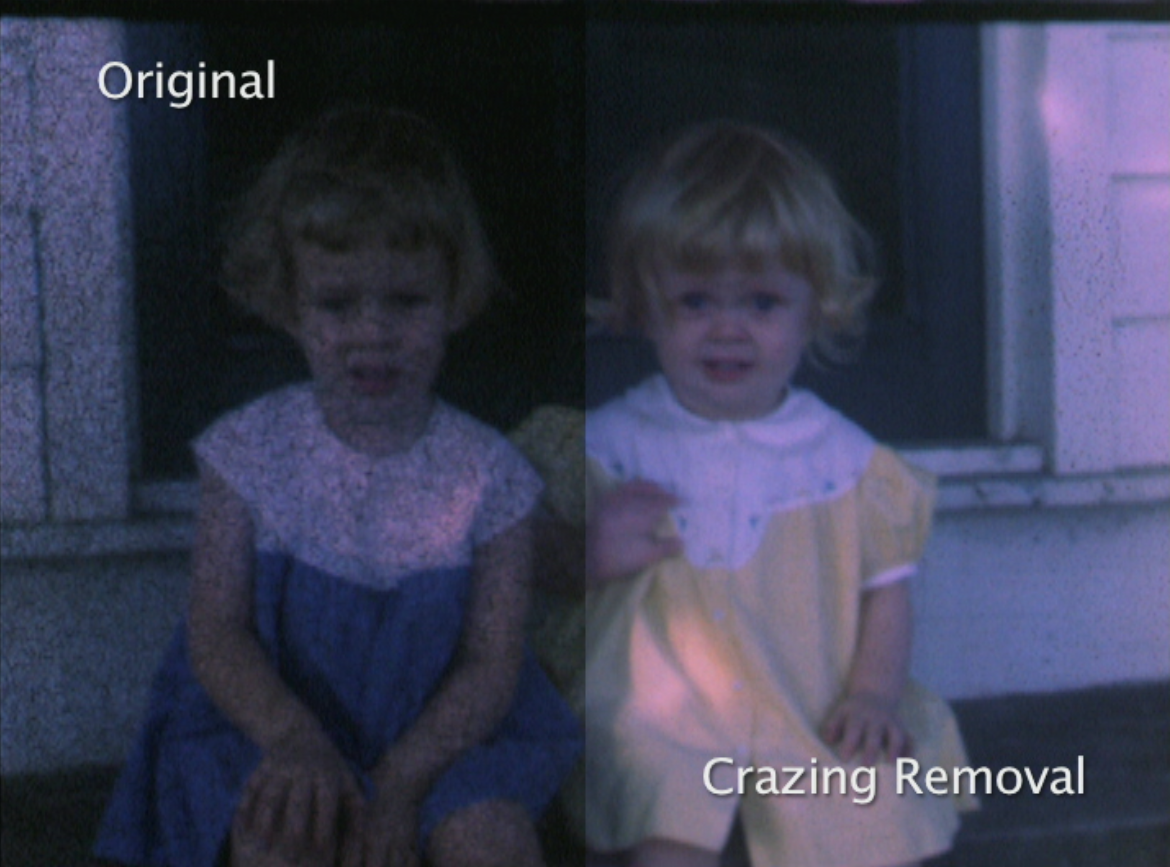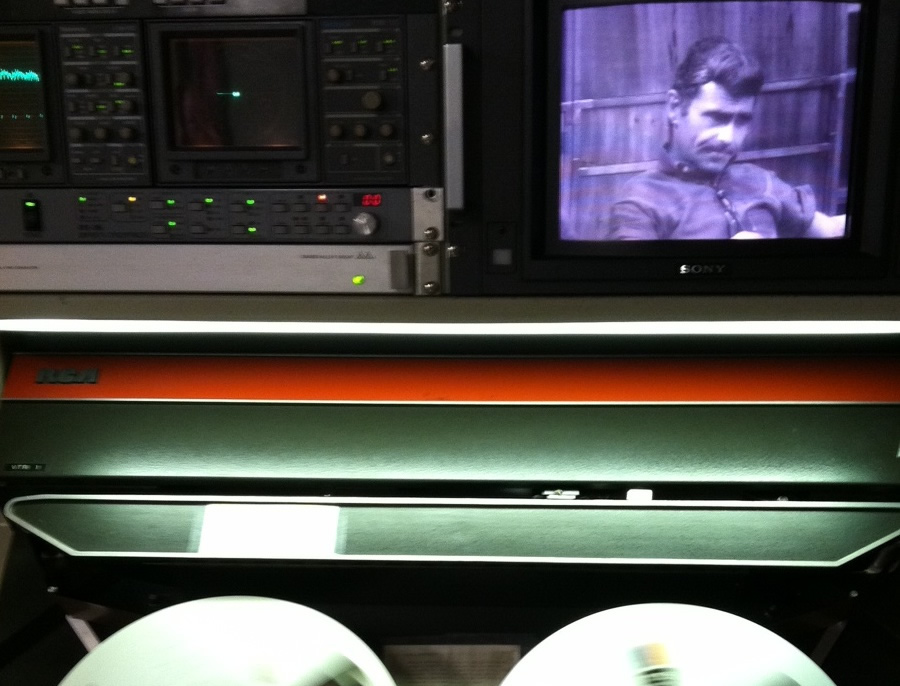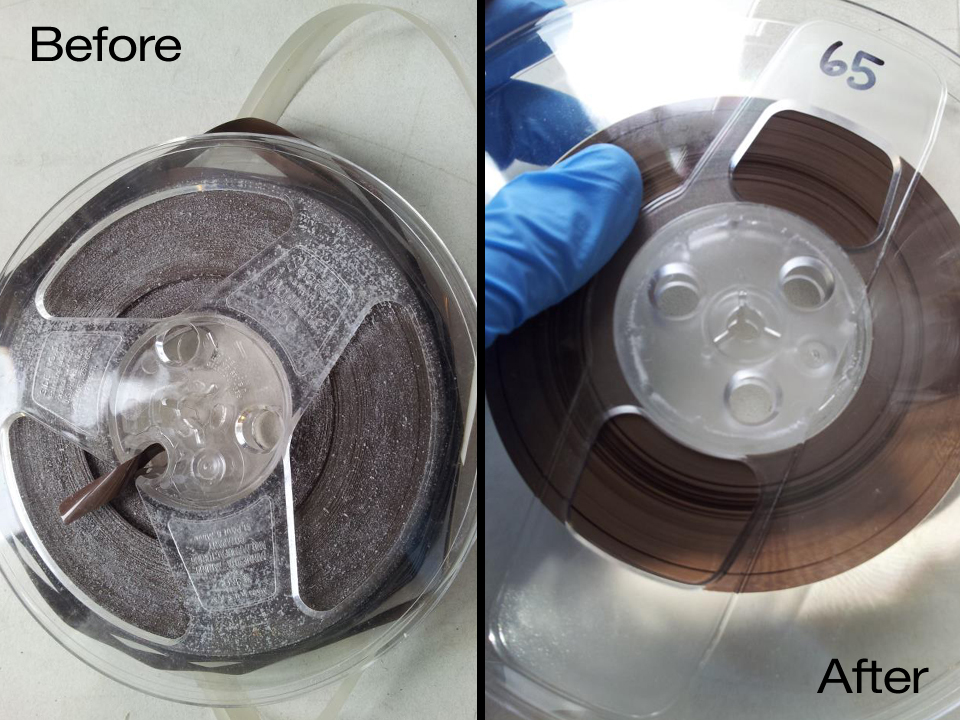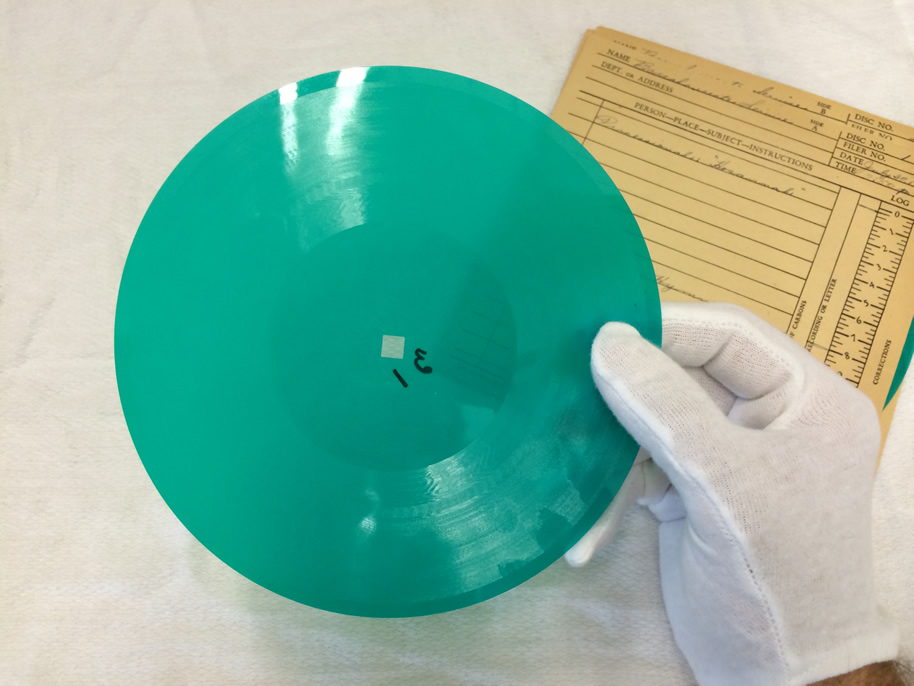Tape Format History
| TAPE FORMATS |
2" TAPE | DEVELOPER | YEAR | INFORMATION |
Quadruplex | Ampex | 1956 | The 2" Quad was the first successful videotape format. The name comes from its four-head wheel which rotated 240 times a second. It was still widely used in the industry in the 1980s. |
Octaplex | RCA | Developed for the military. | |
VR 1500/600 | Ampex | 1963 | May be the first consumer VTR. |
Helical SV-201 | Sony | 1962 | Two-head system that was marketed for industrial, educational, and medical applications. |
ACR 25 | Ampex | 1970 | Automated recording and playback of television commercials. |
IVC 9000 | IVC | 1973 | Helical scan |
TCR 100 | RCA | 1973 | |
1 TAPE | DEVELOPER | YEAR | INFORMATION |
MVC-10 | Machtronics | 1962 | One of the first commercial 1-inch helical scan videotape recorders in the US. |
PI-3V | Precision Instruments | 1963 | Two-head helical scan recorder. |
EV-200 | Sony | 1964 | The first "portable" VTR Sony offered for general use. |
EL-3400 | Phillips | 1965 | Designed for the industrial/educational markets. |
IVC 700/800/900 | IVC | 1967 | Used by TV stations and the military. |
TCR-100 "Quad | RCA | 1969 | These small videotapes allowed broadcasters to access commercials without physically splicing them into the broadcasting program. |
UV-340 or EV-210 | Sony | 1964 | 1" videotape |
1" SMPTE Type A | Ampex | 1965 | Industrial and educational uses. |
1" SMPTE Type B | Bosch | 1976 | Was very popular in Europe. Similar to the Type C format, it uses a segmented helical scan on a small-diameter drum. Each video head pass records 52 lines of video information and is therefore segmented and cannot offer still-frame or slow motion. |
1" SMPTE Type C | Ampex/Sony | 1976 | "C stands for "compromise. Ampex and Sony agreed to a standard 1-inch professional helical format called Type C. Both manufacturers had to slightly modify their designs to create a common format. It is the most popular of the 1" professional formats. Unlike the 2" Quad and the 1" Type B, it offered viewable still frame, slow and fast motion, and picture shuttle. 300 lines of resolution. |
BVH-1000 | Sony | 1976 | Competitor of the Type A. Features of Type A and the BVH-1000 were combined into a common, standardized format Type C. Sony's first Type C machines were also called BVH-1000. |
HDV-1000 | Sony | 1984 | First commercial high-definition format. Recorded component analog video on 1-inch open-reel tape. At the time, HDTV had 1045 active lines. |
1 Analog HDTV | Toshiba | 1985 | First HDTV VTR |
HDD-1000 | Sony | 1988 | First digital component high-definition recorder. At the time, had 1035 active lines. Recordings were made on 1" open reel type C format. ($35,000 for units and 63 minute tapes at $1,300). |
3/4 TAPE | DEVELOPER | YEAR | INFORMATION |
U-Matic | Sony/ JVC/ Matsushita | 1970 | One of the most successful formats of all time. Until its release, news acquisitions had primarily been gathered on 16mm film. Three versions: Low Band (LB) early 70s. High Band (HB) increased chroma subcarrier frequency. 280 lines of resolution. |
U-Matic SP | Sony | 1986 | Improvements over the original format include a higher-energy tape and an extended FM carrier. SP (Superior Performance) had both chroma and luma subcarrier frequencies increased. 340 lines of resolution. |
D1 | Sony | 1987 | First digital VTR. Received little acceptance in broadcast where it was designed for, but was welcomed in graphics production. Due to expensive machines and tapes, it was mainly used in high-end post production facilities that incorporate special effects with multiple layering of video signal. 460 lines of resolution. |
D2 | Ampex and Sony | 1986 | Digital composite format. Advancements in component-based advanced TV ended the interest in composite, including D2. Cassettes hold up to 180 minutes. 450 lines of resolution. |
D6 | Toshiba/BTS | 1995 | Digital HDTV. Uses more heads and offers more audio channels than any other videotape format. |
Digital Component Technology | Ampex | 1992 | DCT was the first format to employ digital video compression to reduce recorded bit rate. |
1/2 TAPE | DEVELOPER | YEAR | INFORMATION |
CV | Sony | 1965 | CV (Consumer Video/Commercial Video) One of the first "affordable" VTRs for consumers. |
VTR-600 | Concord | 1967 | Open-reel black-and-white format. |
1/2" EIAJ Type 1 | Sony/ Panasonic/ others | 1969 | Electronics Industries Association of Japan. AKA AV (Audio/Visual) Low end industrial and educational recordings. Open-reel. |
EIAJ Cartridge | Panasonic | 1971 | AKA Omnivision. Identical to the open-reel EIAJ, only the cartridge makes it different. Tapes were only 30 minutes in length and they had to be completely rewound before it could be removed from the deck. |
Phillips VCR | Phillips | 1970 | The first commercially available home video cartridge machine introduced on the market. Recorded in color and black-and-white. |
AVCO Cartivision | Cartivision | 1972 | Short-lived consumer format that was ahead of its time. It was the first simple consumer video recording and playback system to hit the market. |
V-Cord | Sanyo | 1972 | Consumer home video format. The V-Cord II was the first consumer machine to offer two recording speeds, freeze-frame and slow motion. |
VX | Panasonic/ Quasar | 1975 | "The Great Time Machine". Its one-head helical-scan format required a nearly 360-degree tape wrap. |
Betamax | Sony | 1976 | Was the first successful consumer videocassette. Was a hit at first but later failed in the market place against VHS. Its initial maximum record time of one hour was a disadvantage initially that it was not able to overcome even when it later offered five hour record times. |
VHS | JVC | 1976 | Video home system. The most successful of all home video formats, it was introduced as a competitor of Betamax . videotape. 250 lines of resolution. Maximum tape length is 180 minutes in SP mode, which is 540 minutes in EP mode. |
VHS-C | . | . | videotape. 250 lines of resolution. Maximum tape length is 40 minutes in SP mode, which is 120 minutes in EP mode. The "C stands for compact. With an adapter, tapes will play in a VHS VCR. |
S-VHS | JVC and others | . | S=super. Marketed as a high-end consumer format. "S-video" separates the chrominance (color) and luminance (brightness) signals, although not as purely as the true component systems do. VHS tapes may be played and recorded on S-VHS machines, but S-VHS cannot be played nor recorded on VHS machines. 400 lines of resolution. Maximum tape length is 160 minutes. |
SVHS-C | . | . | videotape. 400 lines of resolution. Maximum tape length is 40 minutes. Compact version of S-VHS. With an adapter, tapes will play in a S-VHS VCR. |
ED Beta | Sony | 1987 | ED (Enhanced Definition) Introduced as a competition to S-VHS. |
Betacam | Sony | 1982 | Aka Type L. Developed as a component-recording professional format to be able to use consumer Betamax cassettes. Records an analog component signal, meaning it is split into three separate channels: red, green and blue. This splitting of channels provides a crisp, true broadcast quality product. 300 lines of resolution. |
M | RCA/ Panasonic | 1982 | Initially called Recam (recording camera) by Panasonic and Hawkeye by RCA. RCA broadcast went out of business shortly after it was released. It was the first component format consisting of two separate signal systems: one for luminance and another for chroma. Originally designed to use VHS tapes. |
MII | Panasonic | 1985 | Introduced as a competitor to beta sp. Splits the video signal into red, green and blue, providing outstanding quality and color. 340 lines of resolution. |
Betacam SP | Sony | 1986 | SP (Superior Performance) was an industry standard for most TV stations and high-end production houses up until the late 90s. 340 lines of resolution. |
D3 | Panasonic | 1991 | Introduced as Panasonics answer to D2, it was promoted as a low-cost digital alternative. Achieved more than twice the recording capacity of D2. 450 lines of resolution. |
Digital Betacam | Sony | 1993 | Digital successor to Betacam. Considered to have almost the same quality as D1 at half the cost and size. High end SDTV. Can playback, but not record Betacam SP tapes. Sony's answer to DCT and D5. |
D5 | Matsushita/ Panasonic | 1994 | Component, non-compressed digital format. Can playback D3 tapes. |
HD-D5 | Panasonic | 1994 | Compressed HD version of D5. Can work with 1080 line and 720 line HDTV formats. |
Betacam SX | Sony | 1996 | Digital format targeted for ENG and newsroom use. Can be sent back to the studio at 2X speed on a standard DS0-3 data connection. |
D9 | JVC | 1995 | Digital S. Rivals the much more expensive Digital Betacam in terms of picture quality. Downward compatible with S-VHS. 540 lines of resolution. |
D9 HD | JVC | 2000 | AKA Digital S-100. Used for recording compressed and sub-sampled HDTV. Uses same tape as D9. |
D-VHS | JVC/ Matsushita | 1997 | Consumer digital format designed to be used with satellite dish systems. |
W-VHS | JVC | 1994 | Analog HDTV Uses a cassette physically identical with VHS. Due to its high cost, it never caught on as a consumer format, and due to its reduced quality, it never caught on as a professional format. |
D11 | Sony | 1997 | AKA HDCAM. Compressed digital HDTV format that employs both subsampling and compression to reduce data bandwidth. |
MPEG IMX | Sony | 2001 | Enhanced picture quality and multi-generation performance. Certain models allow playback of all current broadcast beta formats. |
8 MM TAPE | DEVELOPER | YEAR | INFORMATION |
8mm/ Video8 | EIAJ and others | 1983 | Kodak released first 8mm camcorder in 1984. 255 lines of resolution. Maximum tape length is 120 minutes in SP mode or 240 minutes in LP mode. |
HI8 | Sony | 1989 | Much improved version of 8mm video. Has an optional second AFM track for stereo sound. 415 lines of resolution. Maximum tape length is 120 minutes in SP mode. |
Digital 8 | Sony | 1999 | Records same digital signal as DV onto less expensive Hi8 tapes. Plays back 8mm and Hi8 tapes. A 120 minute Hi8 tape can record 60 minutes of Digital 8. Has analog inputs for digitally archiving existing analog footage. Audio is CD-quality. Only available as camcorders, not decks. |
TAPE | DEVELOPER | YEAR | INFORMATION |
Akai | Akai | 1969 | Open-Reel. Could record video using normal audio tape but the quality was reduced from the special quarter-inch videotape offered by Akai. |
Compact Video Cassette | Funai/ Technicolor | 1984 | CVC was the lightest and most portable recording system of its time. It used quarter-inch cassettes in 30-minute lengths, which contributed to its short life. |
DV | EIAJ | 1996 | AKA miniDV (formerly DVC) Many manufacturers released first DV camcorders in 1995 - Sony, Philips, Thomson, Hitachi, Panasonic, etc. First digital recording format available to consumers. Nearly loss-less broadcast quality picture. Maximum tape length is 80 minutes in SP mode or 120 minutes in LP mode. 500 lines of resolution. |
D7 | Panasonic/ EIAJ | 1995 | AKA DVCPRO. Capable of 4X playback speed. Decks can play back DVCAM. 530 lines of resolution. |
DVCPRO 50 | Panasonic | 1998 | Two more digital channels than DVCPRO. |
DVCAM | Sony | 1996 | Sony's answer to DVCPRO. Includes a feature that allows information to be recorded on a memory chip inside the cassette, such as good and bad take identifiers. 530 lines of resolution. |
DVCPRO HD | Panasonic | 2000 | High-definition version of DVCPRO recording the same signal as D9HD. Machines can play all previous forms of DVCPRO tapes as well as DVCAM and DV tapes. |
D4 | D4 doesn't exist because the number 4 is considered to be a taboo in Asian cultures. |
